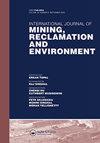Prediction of the pervious surround performance of blast damage zone to reduce groundwater flow in backfilled open-pits
IF 2.6
3区 工程技术
Q3 ENVIRONMENTAL SCIENCES
International Journal of Mining Reclamation and Environment
Pub Date : 2023-01-31
DOI:10.1080/17480930.2023.2170573
引用次数: 0
Abstract
ABSTRACT Reducing groundwater flow in backfilled open-pit to limit interactions of the backfilled wastes with the environment often relies on the creation of preferential flow paths around the disposed wastes in the form of a pervious surround. The blast damage zone, which consists of an enhanced permeability zone near the pit walls, could naturally contribute to creating such preferential flow, thus eliminating the need to build a permeable envelope, reducing costs and maximising the volume for wastes deposition. The objective of this research was thus to propose parameters that could easily be accessed on the field, so practitioners could predict the flow deviation and evaluate if the BDZ is a sufficient containment structure to reduce interactions between backfilled wastes and the environment. Results showed the BDZ deviation could be predicted using the BDZ size and pit wall permeability only, and within a precision of 15% without prior assumptions on the wastes or rock permeability. Three abacuses and one semi-analytical equation were proposed, and several criteria were derived to ensure the BDZ would act as a natural pervious surround. The results of these study should help mining operators and regulatory agencies to assess the BDZ effect on groundwater flow in backfilled open-pits.充填露天矿爆破破坏区透水围护性能预测以减少地下水流
摘要减少回填露天矿中的地下水流量,以限制回填废物与环境的相互作用,通常依赖于在处置废物周围以透水环绕的形式创建优先流动路径。爆破破坏区由靠近坑壁的增强渗透区组成,自然有助于产生这种优先流动,从而消除了建造可渗透外壳的需要,降低了成本,并最大限度地增加了废物沉积的体积。因此,这项研究的目的是提出可以在现场轻松获取的参数,以便从业者可以预测流量偏差,并评估BDZ是否是一个足够的安全壳结构,以减少回填废物与环境之间的相互作用。结果表明,仅使用BDZ尺寸和坑壁渗透率就可以预测BDZ偏差,并且在没有事先假设废物或岩石渗透率的情况下,精度在15%以内。提出了三个算盘和一个半解析方程,并推导了几个标准,以确保BDZ作为一个天然透水环。这些研究的结果应有助于采矿运营商和监管机构评估BDZ对回填露天矿坑地下水流量的影响。
本文章由计算机程序翻译,如有差异,请以英文原文为准。
求助全文
约1分钟内获得全文
求助全文
来源期刊

International Journal of Mining Reclamation and Environment
ENVIRONMENTAL SCIENCES-MINING & MINERAL PROCESSING
CiteScore
5.70
自引率
8.30%
发文量
30
审稿时长
>12 weeks
期刊介绍:
The International Journal of Mining, Reclamation and Environment published research on mining and environmental technology engineering relating to metalliferous deposits, coal, oil sands, and industrial minerals.
We welcome environmental mining research papers that explore:
-Mining environmental impact assessment and permitting-
Mining and processing technologies-
Mining waste management and waste minimization practices in mining-
Mine site closure-
Mining decommissioning and reclamation-
Acid mine drainage.
The International Journal of Mining, Reclamation and Environment welcomes mining research papers that explore:
-Design of surface and underground mines (economics, geotechnical, production scheduling, ventilation)-
Mine planning and optimization-
Mining geostatics-
Mine drilling and blasting technologies-
Mining material handling systems-
Mine equipment
 求助内容:
求助内容: 应助结果提醒方式:
应助结果提醒方式:


